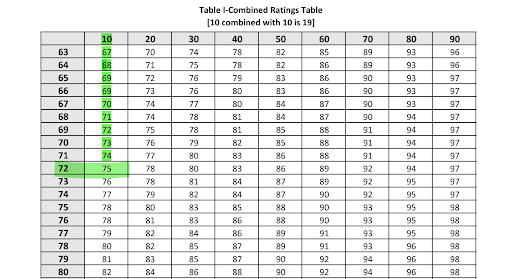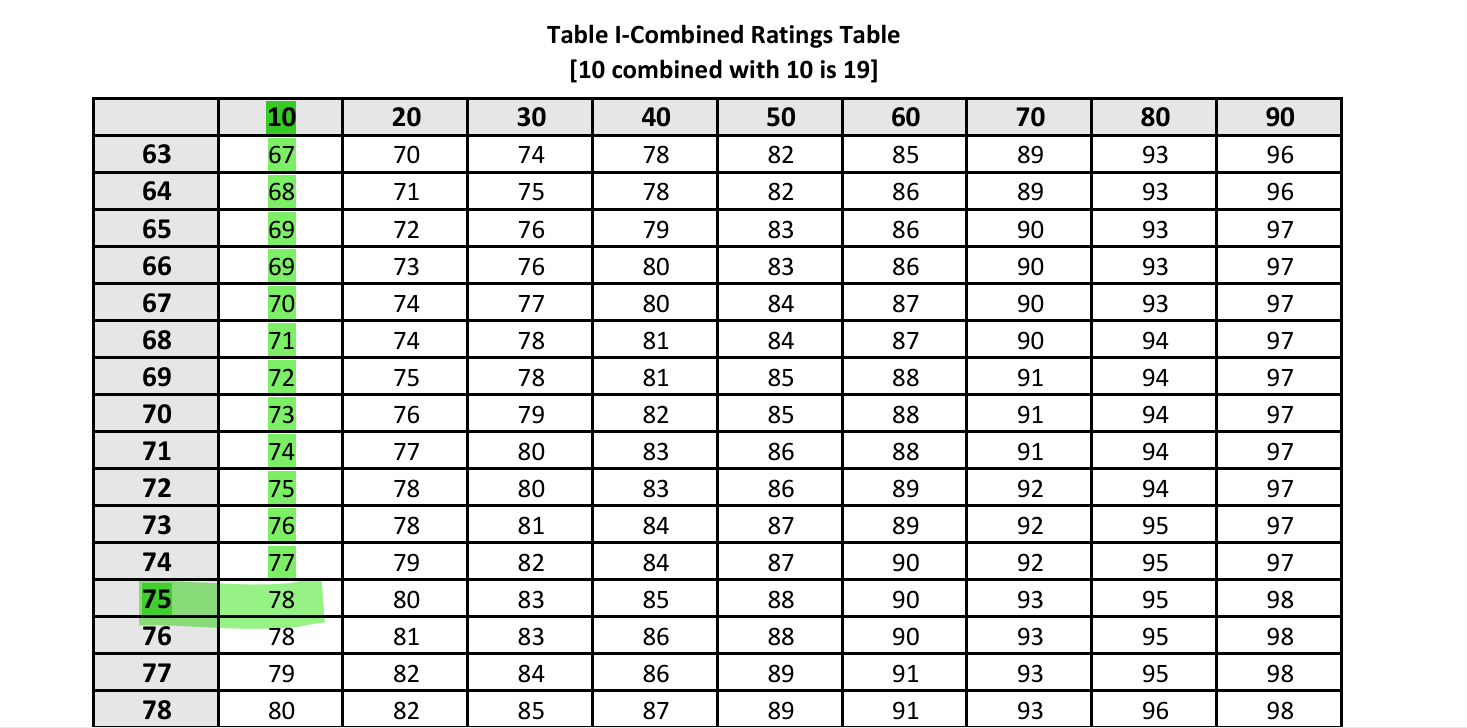Veterans can calculate their combined rating using the VA disability calculator in order to determine what their monthly benefits will be.
Summary
- The VA uses the “Whole Person Theory” to calculate disability ratings.
- The VA disability calculator assesses how multiple conditions cumulatively affect a veteran’s employability rather than adding percentages.
- Veterans can use the VA Combined Rating Table to determine a combined disability rating by integrating multiple service-connected disabilities.
- Veterans with a VA disability rating between 30% and 100% may receive higher compensation if they have dependent children, spouses, or parents.
- Total Disability Based on Individual Unemployability (TDIU) benefits allow veterans with lower combined ratings to receive 100% compensation if they can’t work.

Maneuvering the VA disability rating system can be an uphill task for many veterans seeking to understand their benefits. The system is designed to evaluate the severity of a veteran’s service-connected disabilities and determine the level of compensation they are entitled to receive.
If you are a veteran, it is crucial to grasp how the VA calculates your disability ratings. These ratings directly impact the financial support and resources available to you. By understanding how the VA Disability Calculator works, you can gain insight into your potential benefits and ensure you are receiving the compensation you qualify for.
This tool simplifies the rating process, helping veterans align their expectations and make informed decisions regarding their claims. Understanding the VA’s approach to disability ratings not only empowers you to advocate for yourself but also ensures you are adequately supported post-service.
Our team of veterans disability claim lawyers will gladly guide you through the steps of effectively using a VA Disability Calculator and explain how to maximize your benefits. Schedule a free consultation with us by calling (850) 332-6434 or submitting our contact form today.
The ‘Whole Person Theory’ and Combined Ratings
The VA utilizes the ‘Whole Person Theory’ when calculating the combined disability rating for veterans with multiple impairments. This distinctive method evaluates a veteran’s overall ability to maintain employment rather than their quality of life or compensation structure.
Unlike worker’s compensation, which often considers adjustments to a person’s standard of living, the VA’s system for assessing a combined disability rating is centered on a veteran’s vocational capacity.
The Whole Person Theory operates on the premise that each disability impacts the remaining healthy portion of a veteran’s body. By assessing how these conditions cumulatively affect employability, the VA aims to create a fair representation of a veteran’s ability to work.
As illustrated below, this approach ensures that the combined rating does not simply add percentages together but considers the interconnected impact of multiple disabilities on the veteran’s functional capabilities.
Understanding this distinction is crucial for veterans who want to know how the VA reaches a disability rating determination.
VA Math Vs. Normal Math
Wrapping your head around how the VA calculates disability ratings can seem challenging at first, especially when comparing it to traditional “normal” math. VA disability benefits, which include tax-free compensation and additional support, are determined by your VA Disability Rating.
Calculating Your Combined VA Disability Rating Using VA Math
Unlike conventional math, the VA uses a unique method that applies each new disability percentage to the remaining non-disabled portion of a veteran’s overall health.
Imagine a veteran with three conditions rated at 30%, 20%, and 20%. The VA starts by applying the largest percentage, 30%. Instead of simply adding the next percentage to this, the VA applies 20% to the remaining 70% of non-disability (100% – 30%). This results in 14%, which is then added to the original 30%, totaling 44%.
Adding the third condition, another 20%, involves taking 20% of the remaining 56% (100% – 44%), resulting in 11%. Adding this to the previous total of 44% gives 55%, which is rounded up to 60%. If using regular math, one might expect a straight addition leading to 70%, but VA math is distinctly different.
If this method seems complex, you’re not alone. That’s why the VA disability calculator is available to give you a clearer picture of how the VA combines your disability ratings. This tool offers a simplified estimation to help you navigate the VA’s rating calculation method.
What Does the VA Disability Rating Represent?
Understanding VA disability ratings starts with understanding their significance. These ratings, expressed as percentages such as 20% or 50%, quantify the severity of a veteran’s service-connected injuries or illnesses.
Essentially, they serve as an indicator of how a veteran’s mental or physical condition impacts daily life, influencing activities ranging from family interactions to employment capabilities.
The determination of a VA disability rating is a comprehensive process. It involves evaluating tangible medical evidence, such as records and diagnostic results, which veterans must provide.
Additionally, the outcome of the Compensation and Pension (C&P) examination plays a pivotal role in this assessment. This exam is crucial as it offers first-hand insight into the veteran’s health and functional limitations.
Moreover, the VA may supplement this information with data from other federal agencies and military documentation. The VA relies on multiple sources to gain a holistic view of the veteran’s condition.
These ratings not only reflect the physical or mental health toll on the veteran, but also determine the level of disability compensation they receive. Thus, understanding your VA disability rating is vital. It directly influences the support and compensation available to you. Additionally, it ensures you receive the necessary resources to maintain a quality lifestyle post-service.
How to Use the VA Combined Rating Table to Calculate Your Current Disability Rating
While VA math can often seem complex, using the VA Combined Rating Table, also known as CFR 4.25, is a straightforward process for determining your disability rating. This table helps you integrate multiple disabilities into a single, combined rating. That way, your VA benefits reflect the full impact of your service-connected conditions.
To begin, you are required to list your disabilities, starting with the highest percentage and continuing in descending order. You then have to locate the highest percentage in the left column of the table first. Then, find the next highest percentage across the top row.
The intersection of these two numbers provides the combined value for these disabilities. For instance, if Jane has a 60% disability for PTSD and 30% for a back injury, the intersection gives a combined rating of 72%.

With this new combined value of 72%, repeat the process by placing it in the left column and finding the next highest disability. Say Jane’s 10% knee issue in the top row. The intersection provides a new combined rating of 75%.

Continue this method until all disabilities are accounted for. In Jane’s case, adding a 10% hearing loss rating results in a final combined value of 78%. The final step is to round this number to the nearest 10; in this scenario, it rounds up to 80%.

Accurately calculating your combined disability percentage is crucial, as it determines your monthly payment amount and eligibility for additional types of veteran benefits, such as Total Disability based on Individual Unemployability (TDIU).
Calculating Dependent Parents, Children, and Spouses
When a veteran holds a disability rating between 30% and 100%, having dependents can significantly boost their compensation rates. For instance, consider Jane, who has an 80% disability rating.
Without any dependents, Jane’s monthly payment amount would be $1,444 as of December 1, 2020. However, with a spouse and a dependent child, her compensation rises to $1,922. At this 80% rating, each additional child under 18 adds an extra $69 monthly to the benefits.
Furthermore, if Jane’s spouse qualifies for Aid and Attendance benefits, an additional $129 monthly payment is included to support caregiving needs. It’s also crucial for veterans to promptly update the VA regarding any changes in their marital status or dependent status.
For example, if a child turns 18 and moves out, this change could alter the benefit amount. Nevertheless, compensation might still apply for children over 18. Adult children who were deemed unable to support themselves before reaching adulthood or those enrolled in a qualifying school program can still hold dependent status.
How to Get a Total Disability Rating
Achieving a 100% disability rating from the VA can be a challenging process, but veterans have an alternative option through Total Disability Based on Individual Unemployability (TDIU).
This pathway is particularly beneficial for those who, although not rated at 100% disability, find themselves unable to engage in meaningful employment due to their physical or mental service-connected disabilities.
Qualifying for TDIU Benefits Based on Your VA Rating
TDIU offers veterans the opportunity to receive compensation at the 100% disability rate if they meet certain eligibility criteria. To qualify, a veteran must have one service-connected disability rated at 60% or more.
Alternatively, if a veteran has multiple service-connected disabilities, at least one must be rated at 40% or higher. Also, they must have a combined rating of 70% or more. Additionally, the veteran must demonstrate that these disabilities hinder their ability to maintain substantially gainful employment.
This program recognizes the impact of disabilities that, while not individually rated at 100%, significantly impair a veteran’s capacity to work. Applying for TDIU can provide much-needed financial support, reflecting the true extent of a veteran’s inability to work due to their service-related conditions.
For veterans meeting these criteria, TDIU serves as a vital resource in securing the VA disability compensation they deserve.
Learn How a Bartlett Legal Group VA-Accredited Disability Benefits Lawyer Can Help
The VA disability claims process can seem complex. However, the VA-accredited lawyers from Bartlett Legal Group are here to be your advocates. Our experienced veteran disability appeals attorneys specialize in helping veterans secure the maximum VA disability rating possible.
We meticulously review your case to identify opportunities for increasing your current rating. Additionally, we provide expert guidance in appealing unfavorable VA decisions. Our in-depth understanding of VA regulations and tools like the VA disability calculator means we will present your claim effectively, maximizing your chance for success.
Take the first step towards securing the VA disability benefits you deserve. Contact Bartlett Legal Group today at (850) 332-6434 or submit our contact form to schedule a free consultation with a knowledgeable VA-accredited lawyer. Let us help you navigate the complexities and secure the compensation you are entitled to.







